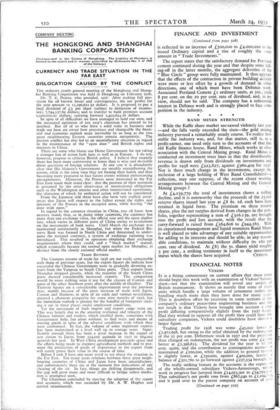RAND MINES STRENGTH
While the Kaffir share market see-sawed violently last yet —and the falls vastly exceeded the rises—the gold mining industry pursued a remarkably steady course. To realise how stable the industry was, and, for that matter, still is, as a profit-earner, one need only turn to the accounts of that fine old Kaffir finance house, Rand Mines, which works in close association with the Central Mining group. Rand Mines is conducted on investment trust lines in that the distributable revenue is drawn only from dividends on investments and profits for 1938 were £923,827, against £960,409 for 1937. Nor is there much change in the investments, except the inclusion of a large holding of West Rand Consolidated—a reflection, may one suppose, of the recent closer working arrangements between the Central Mining and the General Mining groups?
At £4,239,779 the total of investments shows a trifling decline, and it is noteworthy that the proceeds of the 25,000 reserve shares issued last year at £8 6s. id. each have been retained in liquid form. The premium on these reserve shares, plus the net surplus derived from changes in the port- folio, together representing a sum of £316,139, are brought into the profit and loss account, with the result that the carry-forward is raised from £564,606 to £944,565. With its experienced management and liquid resources Rand Mines is well placed to take advantage of any suitable opportunities for adding to its interests and should be able in any reason- able conditions, to maintain without difficulty its i6o per cent. rate of dividend. At £81 the 5s. shares yield roughly 5 per cent., a striking testimony in itself to the investment status which the shares have acquired. CUSTOS.














































 Previous page
Previous page